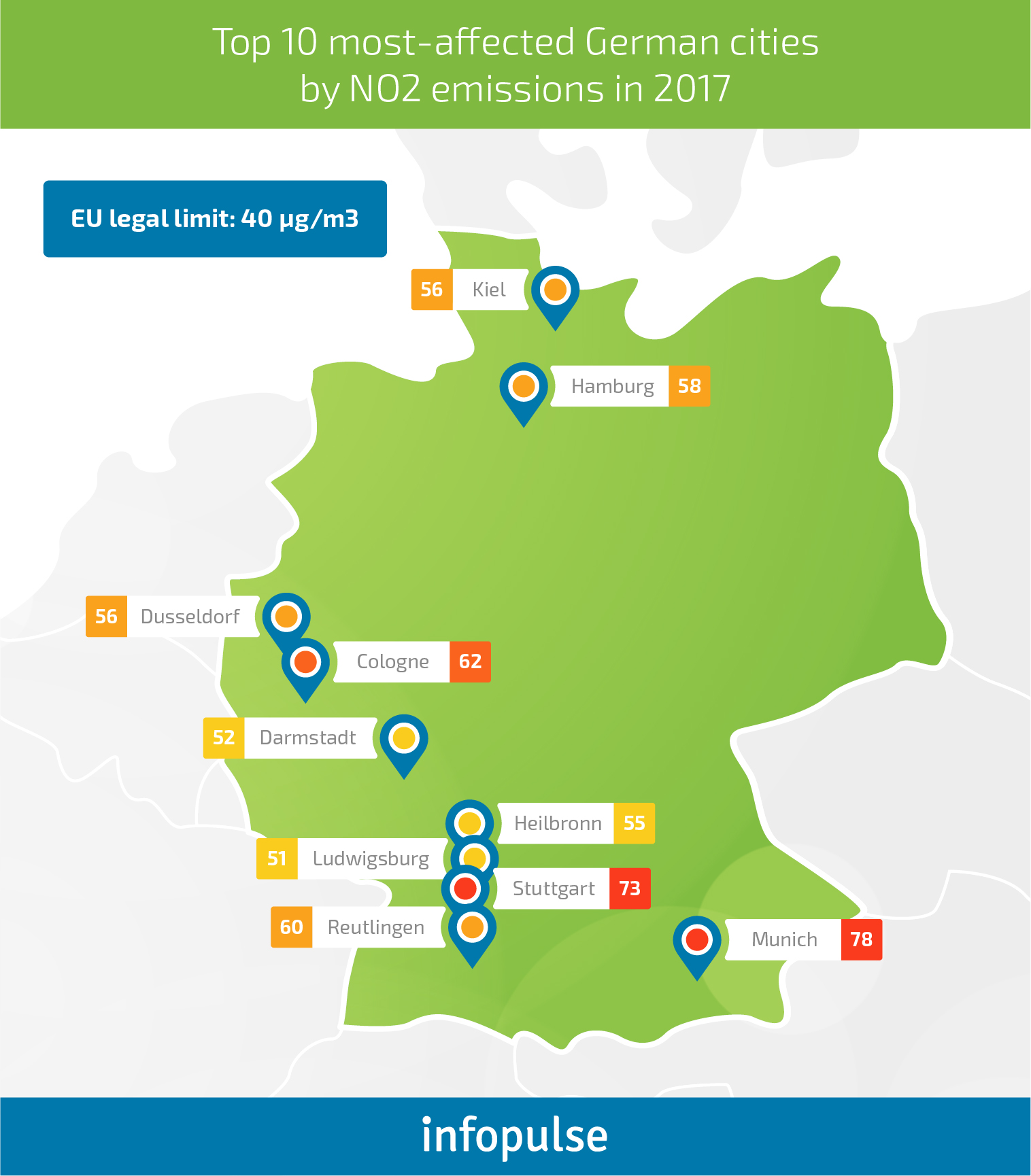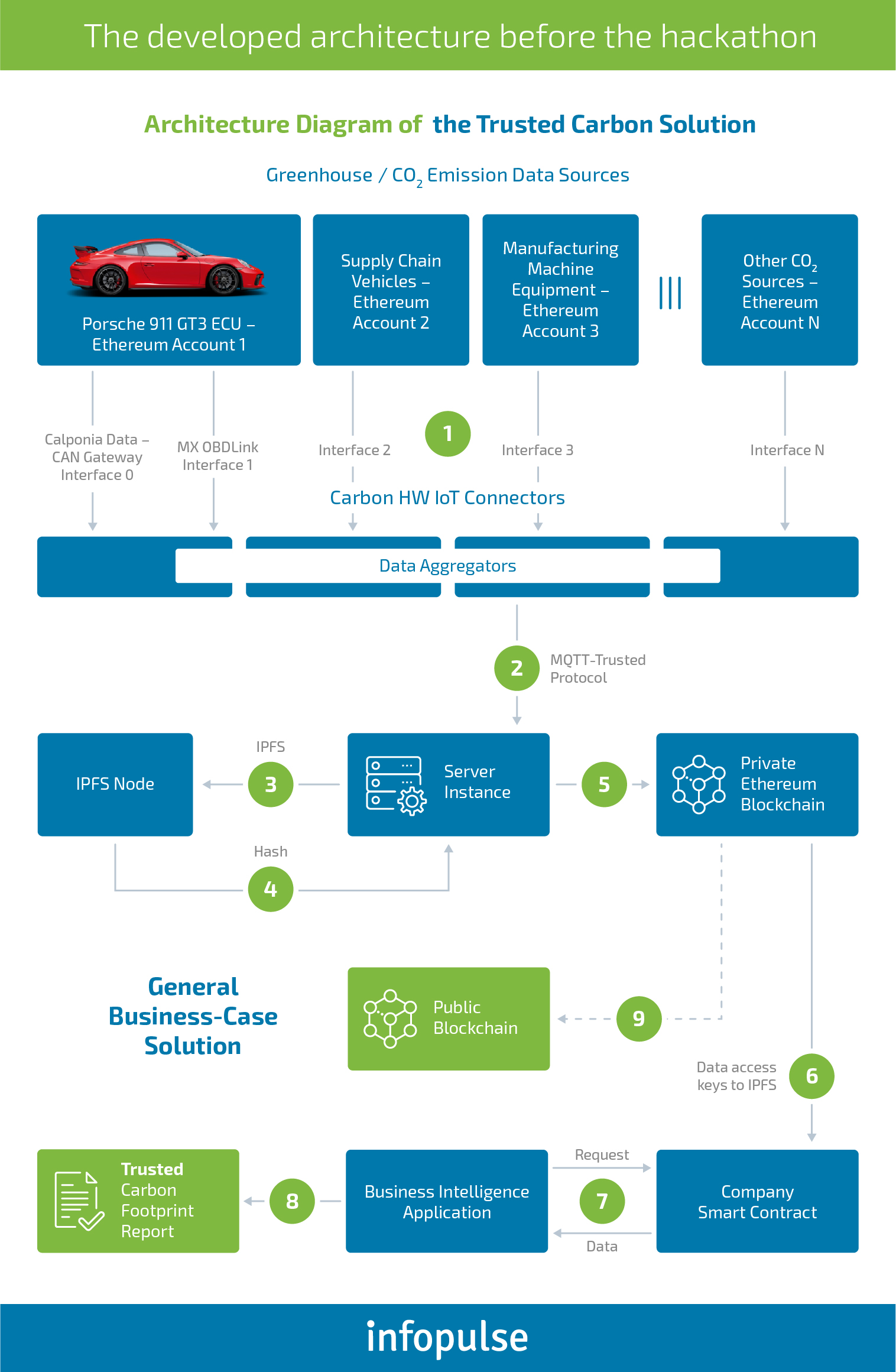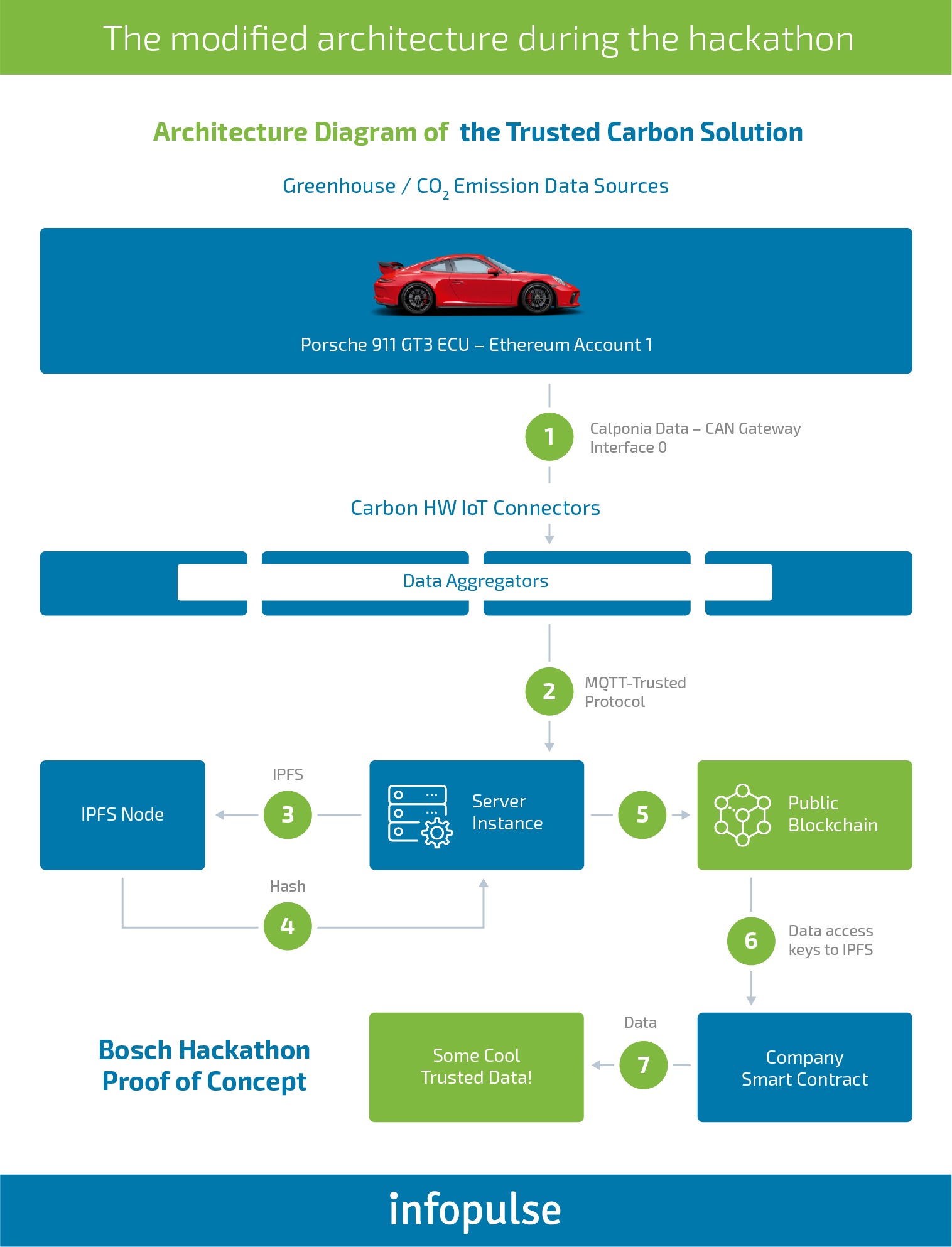A Blockchain & IoT Solution for Calculating Vehicle Emissions Level
The Business Case behind the Solution
Overpopulated world’s cities are greatly affected by nitrogen oxides (NOx) and carbon dioxide (CO2) emissions, which are the result of our direct or indirect activities. Modern diesel cars produce 500 mg of NOx (NO + NO2) emissions per 1 km which is 10 times more than a bus or a heavy truck emits. Their fatal effect can cause asthma and other respiratory illnesses. At the same time, vehicles powered by diesel/gasoline/petrol respectively emit 12.2/8.7/10.4 kg of CO2 per 1 gallon of fuel. There are also other sources of CO2 emitted during the production of plastic items (6 kg of CO2 per 1 kg of plastic) or cheeseburgers (3.1 kg of CO2 per 1 item), etc. Unfortunately, today we cannot completely reduce all emissions but only decrease their amount to the acceptable level. For instance, even with the new technologies like SCR, FLOX, water injection, NOx emissions can be cut only to 50%-84%.
Besides, the full transition to electric vehicles can take for about 8 or 10 years, as different sources predict. Until then, air pollution can reach its critical levels of NOx and CO2 concentration affecting the spread of serious health problems.
A solution that provides an objective picture of any vehicle’s emissions data, which is impossible to fabricate at the same time, can help such European countries like Germany, Belgium, Netherlands, Sweden and others to effectively manage the traffic flow in the established Low Emission Zone (LEZ). Only in Germany, 26 cities exceed the European Union air pollution limits. In the map below, you can see what parts of the country are the most affected by nitrogen dioxide (NO2) emissions.

In 2008 and 2009, Stuttgart and Dusseldorf, as two most air-polluted cities, received LEZ status, which allowed prohibiting vehicles with a high emissions level from entering their urban areas. Only vehicles with stickers on the acceptable emission level can get into the city centers.
By the way, this year the Federal administrative court in Leipzig has ruled that all German cities can implement the same entry restrictions for diesel vehicles all across the country. Regulators, as well as manufacturers, will be obliged to follow the limits of emissions level. The problem is that the system with stickers does not provide enough efficiency, transparency, and control. Moreover, the famous Dieselgate case clearly illustrates that a regulatory system cannot simply rely on a manufacturer’s reputation. Instead, the system requires an independent solution that checks and gathers results on real-time emissions deprived of further speculations.
Solution and Its Benefits for the Business
The Infopulse team came up with a concept under a working title “The Trusted Carbon”. This is the blockchain-based solution with IoT features that allows gathering, calculating and securely documenting data on any vehicle’s emissions (carbon footprint, NOx, etc.), storing their results in a public decentralized blockchain network. The records on emissions will be opened to all participants in a network but safeguarded from further tampering or editing. Also, since the blockchain network is distributed, meaning the added data to each block is stored on the computers of all participants, no central point will control an access to the whole database.
For the business, including OEMs, Tier 1, 2, and 3 suppliers, this solution allows confirming their sustainability, demonstrating high environmental responsibility and readiness to comply with current environmental regulations.
Large logistics companies with global supply chains like DHL Logistics, CEVA logistics, XPO logistics, FedEx, etc. can apply our solution to calculate, control, and optimize their overall corporate carbon footprint and NOx level. Most importantly, due to the tamper-proof blockchain system, a company does not need to additionally verify credibility of the reported emission data.
As the Managing Director of Infopulse Europe GmbH, Juergen Selig points out:
At the same time, municipal authorities get a good tool to carry out their driving ban for diesel vehicles. The mechanism of choosing what cars are prohibited from entering an urban area will become simple and transparent: the regulating system on the controller’s side will automatically verify or deny an access to a specific vehicle by addressing the blockchain network.
It can also function as an additional controlling tool for a regulator to check on a number of emissions a specific vehicle produces preventing a driver’s fraud. By the way, a driver can also use Infopulse’s solution to plan own trip in regard to local NOx and CO2 limitations in a particular city.
The Trusted Carbon Solution Architecture
A few months before the IoT hackathon in Berlin, the Infopulse team thoroughly analyzed the business case and developed the high-level architecture of the Trusted Carbon solution creating a complex diagram of the following processes.

However, during the hackathon, the team simplified the solution architecture to meet tough deadlines of the competition. Relying on solid expertise in the automotive industry and broad competencies in IoT, Ethereum Blockchain, and Smart Contracts, the team managed to develop and implement an efficient algorithm of the solution.
One of the requirements at the hackathon was to integrate the developed concept with a Bosch solution like mySPIN SDK, Calponia, Bosch Connected Services, Bosch IoT Cloud, etc. Our team used Bosch Calponia, an online platform for engineering solutions, as a source of Porsche GT3 emission data provider. You can see how it was integrated in the first phase of both extended and simplified architecture diagrams.
The team can also enable integration with Bosch mySPIN solution, which will allow a user to access data on the current emissions and own driving behavior statistics through the mySPIN interface.
Most importantly, the team implemented the concept and prepared a ready-to-use solution, which was tried and tested in real-time conditions.
Let’s take some time to understand how Infopulse’s solution works.

An IoT device integrates with the car through the OBD-2 port and gathers diagnostic data on CO2, NOx or other emissions received as an input of specific figures. The IoT device also contains the vehicle’s account data such as an identifier and a password. After the information on the number of emissions is filtered, structured and signed, it is transferred together with the vehicle’s account data to a Server Instance through the MQTT-trusted protocol. It is lightweight, open, and simple but reliable for delivering a publish-subscribe message in a resource-constrained environment of IoT devices.
To secure data from any manipulations, the file with data is transferred from the Server to the IPFS system, which keeps the complete data set and returns a hash to the server. The added hash is unique for each file and functions as a path to the file. Changing any data in the file will also affect the hash in IPFS, which is also saved in the blockchain. Since any data in the blockchain is impossible to temper, by comparing a hash stored in the blockchain and a hash in the IPFS system, we can check whether the data in IPFS is authentic.
What’s in it for us?
The participation in Bosch IoT Hackathon helped Infopulse gain new practical experience and trial-test our capabilities at the international level. Besides, we managed to demonstrate our innovative R&D potential in the automotive industry, strong expertise in IoT, blockchain, and ability to integrate our solutions with Bosch connectivity solutions.
Bosch ConnectedWorld 2018 was our first international hackathon of that kind. We got a perfect opportunity to network with other involved teams and received positive feedback on our solution from top experts in the related industries. The hackathon participation was a good chance to evaluate our own efforts and approaches professionally applied to the development of the existing concept. We also verified the viability of our solution and simplicity of its implementation. At the same time, by enabling a blockchain ecosystem for emissions documentation will help manufacturers and regulators build trust and simplify compliance with numerous sustainability requirements and regulations.

![CX with Virtual Assistants in Telecom [thumbnail]](/uploads/media/280x222-how-to-improve-cx-in-telecom-with-virtual-assistants.webp)
![Generative AI and Power BI [thumbnail]](/uploads/media/thumbnail-280x222-generative-AI-and-Power-BI-a-powerful.webp)
![AI for Risk Assessment in Insurance [thumbnail]](/uploads/media/aI-enabled-risk-assessment_280x222.webp)
![Super Apps Review [thumbnail]](/uploads/media/thumbnail-280x222-introducing-Super-App-a-Better-Approach-to-All-in-One-Experience.webp)
![IoT Energy Management Solutions [thumbnail]](/uploads/media/thumbnail-280x222-iot-energy-management-benefits-use-сases-and-сhallenges.webp)
![5G Network Holes [Thumbnail]](/uploads/media/280x222-how-to-detect-and-predict-5g-network-coverage-holes.webp)

![How to Reduce Churn in Telecom [thumbnail]](/uploads/media/thumbnail-280x222-how-to-reduce-churn-in-telecom-6-practical-strategies-for-telco-managers.webp)
![Automated Machine Data Collection for Manufacturing [Thumbnail]](/uploads/media/thumbnail-280x222-how-to-set-up-automated-machine-data-collection-for-manufacturing.webp)
![Money20/20 Key Points [thumbnail]](/uploads/media/thumbnail-280x222-humanizing-the-fintech-industry-money-20-20-takeaways.webp)